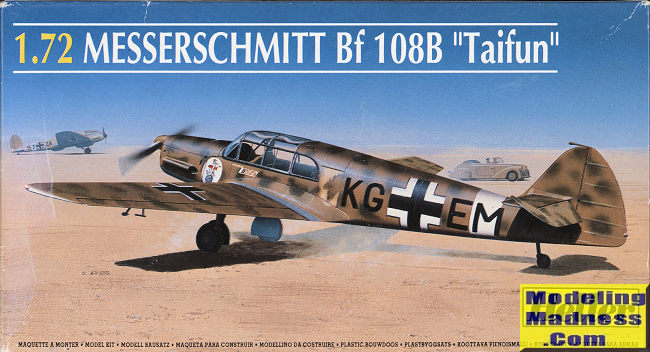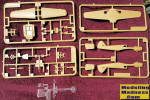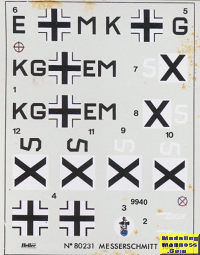
Heller 1/72 Bf-108B 'Taifun'
| KIT #: | 80231 |
| PRICE: | $cheap |
| DECALS: | Two options |
| REVIEWER: | Scott Van Aken |
| NOTES: |

| HISTORY |
Originally designated the M 37, the aircraft was designed as a four-seat sports/recreation aircraft for competition in the 4th Challenge International de Tourisme (1934). The M 37 prototype flew first in spring 1934, powered by a 250 PS (247 hp, 184 kW) Hirth HM 8U 8.0 litre displacement, air-cooled inverted-V8 engine, which drove a three-blade propeller.
Although it was outperformed by several other aircraft in the competition, the M 37's overall performance marked it as a popular choice for record flights. Particular among these traits was its low fuel consumption rate, good handling, and superb takeoff and landing characteristics.
The Bf 108A first flew in 1934, followed by the Bf 108B in 1935. The Bf 108B used the substantially larger, 12.67 litre displacement Argus As 10 air-cooled inverted V8 engine. The nickname Taifun (German for "typhoon") was given to her own aircraft by Elly Beinhorn, a well-known German pilot, and was generally adopted.
The Bf 108 was adopted into Luftwaffe service during World War II, where it was primarily used as a personnel transport and liaison aircraft. The aircraft involved in the Mechelen Incident was a Bf 108.
Production of the Bf 108 was transferred to occupied France during World War II and production continued after the war as the Nord 1000 Pingouin.
| THE KIT |
 I
mentioned in an earlier preview that Heller, for a time, was producing new kits
at a prodigious rate and one of those was this very nice Bf-108. It has only bee
fairly recently that a new tooling has been done by Fly and while I haven't seen
it, I doubt if it is any easier to assemble than this one.
I
mentioned in an earlier preview that Heller, for a time, was producing new kits
at a prodigious rate and one of those was this very nice Bf-108. It has only bee
fairly recently that a new tooling has been done by Fly and while I haven't seen
it, I doubt if it is any easier to assemble than this one.
Molded in tan to match the main markings option, the kit is really not lacking much. It provides a fairly nice interior with two front and a rear bench seat, two control sticks and an instrument panel. There is also a rear bulkhead. This assembly fits atop the one piece lower wing and the upper wing halves attach to it. There is no boxed in main gear well.
The fuselage halves are then assembled with the rear quarter
windows inserted from inside. With the halves joined, the tailplanes and their
struts are added along with the tail gear. The nose is a separate
 piece to
allow the prop to spin if you so wish it. This is all attached to the wing
assembly along with the main gear. Clear bits have well defined frame lines and
once glued on completes the kit.
piece to
allow the prop to spin if you so wish it. This is all attached to the wing
assembly along with the main gear. Clear bits have well defined frame lines and
once glued on completes the kit.
Instructions have four construction steps with Humbrol paint numbers. Markings are for two planes. One is the box art plane in a desert scheme based on Sicily in 1943 while the other is a yellow nosed Bulgarian plane in RLM 70 or 71 over 65. Decals are the same as since the initial release and are fairly matte. No swastika is provided. There are aftermarket decals out there to replace the kit ones and I recommend locating them.
| CONCLUSIONS |
Those wanting a newer tooling with engraved panel lines will want the newer and undoubtedly more complex Fly kit. Others will be quite pleased with the results of building this particular version.
| REFERENCES |
https://en.wikipedia.org/wiki/Messerschmitt_Bf_108_Taifun
October 2020
Copyright ModelingMadness.com. All rights reserved.
Thanks to for the review kit. You can find this kit at your favorite hobby shop or on-line retailer
If you would like your product reviewed fairly and fairly quickly, please contact the editor or see other details in the Note to Contributors.
Back to the Main Page Back to the Review Index Page Back to the Previews Index Page